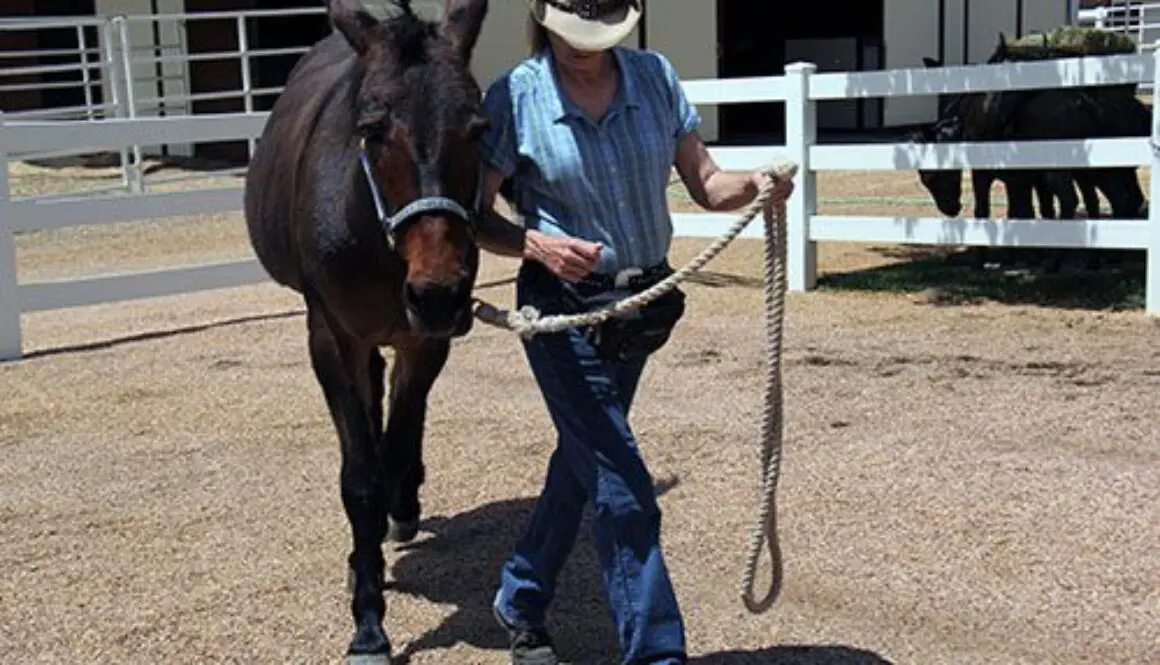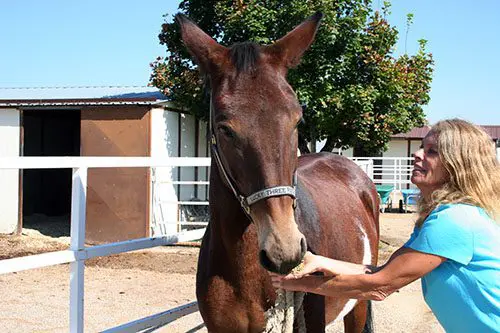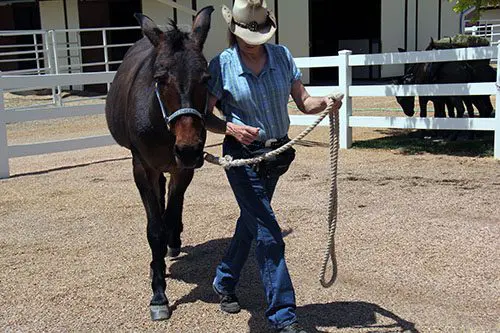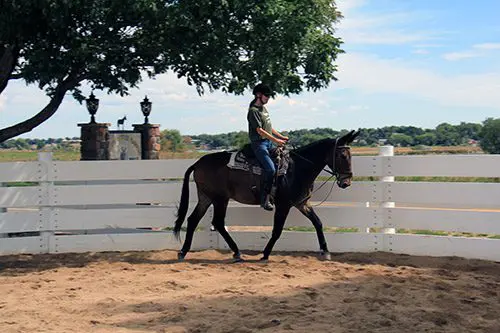MULE CROSSING: Equine Behavior: Look Who’s Talking! Part 3
By Meredith Hodges
In Part 1 of Equine Behavior: Look Who’s Talking, we discussed the evolution of man’s self-discovery and how he applied this to his approach to equines. If we want to manage our equines in a healthy way and accomplish even the most basic performance with them, there is much to consider during the training process. In Part 2 of Equine Behavior: Look Who’s Talking, we learned that equines are honest in their nature, and produce quick and honest reactions to a stimulus. Therapeutic Riding provides and exemplary teaching experience for both the human and the equine. Those of us with our own equines can now derive much more from our relationships with equines than we ever thought possible.
During centuries of use, equines have been asked to perform many tasks, as they have always been essential in agriculture, for transportation in cities and as fighting partners in the military. People who worked regularly with these animals had an appreciation for their overall health and longevity. Although people were limited by their own experience, they would generally provide the best possible care because the equine was an integral part of their economy. Many horses, and most mules and donkeys, worked hard to build this world and support people in their endeavors. It is always amazing when one realizes the expanse of equines’ contributions to our wealth and welfare.
Original Dressage training was concerned with the systematic conditioning of the body of the horse in a way that would make him a durable and viable war partner for soldiers. The horse was revered and allowed time for his body to mature and grow slowly. The training followed suit, yielding a healthy and formidable opponent in any competition. This goal was achieved only when the animal was trained in good posture, and given adequate time to complete each stage of training as his own potential dictated.
 When proper attention is given to the development of balanced, postural core muscle strength from the very beginning, the equine develops strength symmetrically throughout his body as he grows. Muscles are stressed and relaxed at critical intervals, allowing for healthy mental, physical and emotional growth. When the equine feels good in his body, it clears his mind to concentrate on his performance. The result is an equine that is happy in his work and in his world.
When proper attention is given to the development of balanced, postural core muscle strength from the very beginning, the equine develops strength symmetrically throughout his body as he grows. Muscles are stressed and relaxed at critical intervals, allowing for healthy mental, physical and emotional growth. When the equine feels good in his body, it clears his mind to concentrate on his performance. The result is an equine that is happy in his work and in his world.
Colonel Alois Podhasky (1898-1973), former head of the Spanish Riding School in Vienna, Austria said, “I’ve got time!…We can only achieve the highest goals in the art of riding when we increase our demands on the horse in a systematic manner.” (1)
The same holds true with any athlete. No animal can perform at their highest level and remain healthy without building the body correctly over a significant period of time. Forcing things and moving too fast through training levels does not allow healthy athletic conditioning to take place. This conditioning art is becoming lost in the economic world today as equines are no longer being used as a necessity. They have become a hobby, or a sport in more developed countries, and are an economic necessity only in Third World countries that are not equipped to provide the extensive care that a healthy equine demands.
 Dressage training has evolved from a useful tool to strengthen and balance a useful horse to just another name in Big Business. Today, equines are thought of as economic commodity, or a breeding investment, and are used in events such as Reining, Cutting, Stadium Jumping, Racing, Steeplechase, Eventing, Hunting, Dressage and just-for-pleasure riding. Monetary investment is high, and never was the old adage of “horse poor” more prevalent than now!
Dressage training has evolved from a useful tool to strengthen and balance a useful horse to just another name in Big Business. Today, equines are thought of as economic commodity, or a breeding investment, and are used in events such as Reining, Cutting, Stadium Jumping, Racing, Steeplechase, Eventing, Hunting, Dressage and just-for-pleasure riding. Monetary investment is high, and never was the old adage of “horse poor” more prevalent than now!
 Owners can expect to spend thousands of dollars in a year for no more than a pleasure riding equine, and the cost increases with the status of the activities. The cost of supporting an equine provides economic success to a multitude of businesses such as feed stores, tack and equipment, truck and trailer sales, drug companies, motels, gas stations, county fairgrounds, breed registries, brand inspection, clothing stores, veterinarians, farriers, and the list goes on.
Owners can expect to spend thousands of dollars in a year for no more than a pleasure riding equine, and the cost increases with the status of the activities. The cost of supporting an equine provides economic success to a multitude of businesses such as feed stores, tack and equipment, truck and trailer sales, drug companies, motels, gas stations, county fairgrounds, breed registries, brand inspection, clothing stores, veterinarians, farriers, and the list goes on.
In any business, moving product faster is always better because it decreases overhead costs. Anything long-lasting takes more expense to produce and does not afford repeat customers as often. The same product is therefore, less valued. But good business sense is in direct opposition to what is actually good and healthy for the equine. Good business sense is what drives people to train equines faster, and why people ask young equines to perform way beyond their level of capability, to promote a faster sale of the equine, which ultimately results in the untimely demise of the equine.
 Breeding for bigger, better and faster equines, has given people the false idea that these horses perform almost solely from their heredity. This has changed how they are being trained and judged. Today, many equine competitions are no longer judged by an expert who really knows the definition of correct movement. We are inundated with terminology from the Masters that is most often misunderstood and distorted.
Breeding for bigger, better and faster equines, has given people the false idea that these horses perform almost solely from their heredity. This has changed how they are being trained and judged. Today, many equine competitions are no longer judged by an expert who really knows the definition of correct movement. We are inundated with terminology from the Masters that is most often misunderstood and distorted.
For instance, collection is defined by the United States Equestrian Federation as, “a. to further develop and improve the balance and equilibrium of the horse which has been more or less displaced by the additional weight of the rider, b. to develop and increase the horse’s ability to lower and engage his hindquarters for the benefit of lightness and mobility of his forehand, and c. to add the ‘ease and carriage’ of the horse and to make him more pleasurable to ride.”
 To those who are not schooled in Dressage, collection can mean a lot of things that are contrary to the actual definition, including the belief that it means to merely break at the poll and arc the head and neck. People also believe that an equine is on the bit if he arcs his head and neck and flexes at the poll. What this actually means is that the equine has taken contact with the bit, and can feel the hands of the rider through the reins, and respond lightly and obediently whether his head and neck are arched or not. Vertical flexion is the result of correct collection that involves the entire body of the equine, when the equine is flexible from head to tail with the hindquarters properly engaged. It is not the act of bringing the equine’s chin to his chest. Lateral flexion is when the equine bends his whole body through his rib cage to the arc of a circle, and is not just bending his head and neck to your knee.
To those who are not schooled in Dressage, collection can mean a lot of things that are contrary to the actual definition, including the belief that it means to merely break at the poll and arc the head and neck. People also believe that an equine is on the bit if he arcs his head and neck and flexes at the poll. What this actually means is that the equine has taken contact with the bit, and can feel the hands of the rider through the reins, and respond lightly and obediently whether his head and neck are arched or not. Vertical flexion is the result of correct collection that involves the entire body of the equine, when the equine is flexible from head to tail with the hindquarters properly engaged. It is not the act of bringing the equine’s chin to his chest. Lateral flexion is when the equine bends his whole body through his rib cage to the arc of a circle, and is not just bending his head and neck to your knee.
All of these movements take many years to cultivate if they are to be done correctly. There are specific exercises to do at every stage to make sure that the equine is developing properly and executing these movements on his own, with only the most subliminal support from the rider’s aids. Most equines that are shown today are not engaged sufficiently behind and are doing “High School” movements out of good equine posture. They are clearly on the forehand and unbalanced.
If one is to develop the equine in a sound manner, then one must learn to appreciate the smaller victories at each stage of training and during every lesson. One needs to learn to appreciate the incredible ways that one can affect balance and movement during Leading Training. Leading Training can teach the equine good balance, proprioception (body awareness) and regularity of the footfall patterns.
The equine will become strong and balanced in his core muscles (and all the elements that support his skeleton) using simple tasks that appear in the Hourglass Pattern and later through obstacles for coordination. Only after your equine is able to take responsibility for his own balance and negotiation of these movements should he be asked to go to the Round Pen to learn to balance on a circle at all three gaits. Only then will he be able to maintain equal weight over all four feet, bend properly through his torso and not lean like a motorcycle.
Only after he is able to sustain his own balance on the circle through all three gaits (walk, trot and canter), stop, back and reverse, and has been Ground Driven long enough to submit lightly to the bit through all movements, should he be mounted and asked to carry a rider. Even lunging on the lunge line should first be taught in the Round Pen, so when you do lunge him in an open area, he will know the cues to keep him on the circle and has the ability to balance himself.
 You would teach him to lunge on the lunge line in the Round Pen first with enough slack in the line so it drags on the ground as he circles. Keep a slightly open fist on the line and close your first as the outside front leg comes forward into suspension. He will feel this pressure and bring that front leg onto the circle instead of going straight forward with it. This is the cue you will use when lunging him on the line in the open arena.
You would teach him to lunge on the lunge line in the Round Pen first with enough slack in the line so it drags on the ground as he circles. Keep a slightly open fist on the line and close your first as the outside front leg comes forward into suspension. He will feel this pressure and bring that front leg onto the circle instead of going straight forward with it. This is the cue you will use when lunging him on the line in the open arena.
The equine that has had the benefit of postural core strength training will be safer on the trail and flawless in the show ring. If you take the time to develop your equine properly, during these seemingly boring tasks, you might very well discover a healthier and happier YOU!
It is difficult for judges without roots in agriculture to conflict with the roar of the crowds at shows as they see fancy movements. If the judge does not hold true to what is truly correct and allows himself to be swayed by the audience, the integrity of the equine industry is lost. Our equines will continue to suffer at the hands of ignorance because there are no clear standards by which to educate people. The equine that is properly trained should appear to be performing of his own volition. If he does not appear this way, and is constrained or forced, he is not in correct posture or balance and cannot perform correctly. The integrity of his movement is lost and the longevity of his life is compromised.
When you take the time to feed, maintain and train your equine as he should be trained as an athlete, his personality will begin to emerge. You will be surprised at the relationship you will have with him and the wondrous sensations you can feel when you are in true harmony with him. You will no longer be just an observer, but rather, a friend and partner in performance, and in life! You have laid the foundation for both of your personalities to grow in the most positive way and will develop the deepest bond possible.
To learn more about Meredith Hodges and her comprehensive all-breed equine training program, visit LuckyThreeRanch.com or call 1-800-816-7566. Check out her children’s website at JasperTheMule.com. Also, find Meredith on Facebook, YouTube, Pinterest, Instagram, MeWe and Twitter.
Covered in TRAINING MULES & DONKEY: A LOGICAL APPROACH TO TRAINING, TRAINING WITHOUT RESISTANCE, EQUUS REVISITED and A GUIDE TO RAISING & SHOWING MULES at www.luckythreeranchstore.com
© 2011, 2016, 2024 Lucky Three Ranch, Inc. All rights reserved.
1Tug of War: Classical vs. Modern Dressage by Dr. Gerd Heuschmann, pg. 38, Copyright © 2006 Wu Wei Verlag, Schondorf, Germany, English translation Published by Trafalgar Square Books, North Pomfret, Vermont, 05053, USA 2007 (Footnote: Podhasky, Alois, ibid: Mossdorf, Carl Friedrich (1989), p. 142)




 Shaping behaviors takes reinforcement to the next level. Now you are working with the tendency of an animal to perform in the right way and guiding that performance toward your ultimate goal. This is called successive approximation. For example, if you are teaching a turn on the haunches on the lead line, you must first ask for one step forward. Then walk toward your animal’s shoulder and ask for the turn. In order to teach him to plant his rear pivot foot before the turn, the process must be broken down into smaller steps. First, ask for the step forward and reward him immediately when he complies. Then move on and ask for one step forward and one to the side, rewarding him again when he’s successful. Then ask for one step forward and two to the side and reward, and so forth.
Shaping behaviors takes reinforcement to the next level. Now you are working with the tendency of an animal to perform in the right way and guiding that performance toward your ultimate goal. This is called successive approximation. For example, if you are teaching a turn on the haunches on the lead line, you must first ask for one step forward. Then walk toward your animal’s shoulder and ask for the turn. In order to teach him to plant his rear pivot foot before the turn, the process must be broken down into smaller steps. First, ask for the step forward and reward him immediately when he complies. Then move on and ask for one step forward and one to the side, rewarding him again when he’s successful. Then ask for one step forward and two to the side and reward, and so forth. An example of shaping a behavior by breaking it down into a string of very small steps is how I taught my donkey, Little Jack Hornerto canter. Although many people tried to tell me that donkeys don’t canter, I had seen donkeys canter when they ran free, so I knew it was possible. First, I set the goal of cantering a circle. No one could run ahead of my donkey fast enough to reward him with oats and negative reinforcement such as the crop didn’t work well at all, so I had to find another kind of reinforcement. Using the pleasure principle of finding the best motivation for an action, I put my cycling broodmares into a pen at one end of our hayfield and I took my jack to the other end. When asked to canter toward those mares, he did so eagerly. He first learned to canter in a straight line. I reinforced the action verbally with, “Good, good,” while we cantered, and then I gave him a food reward once we reached the pen.
An example of shaping a behavior by breaking it down into a string of very small steps is how I taught my donkey, Little Jack Hornerto canter. Although many people tried to tell me that donkeys don’t canter, I had seen donkeys canter when they ran free, so I knew it was possible. First, I set the goal of cantering a circle. No one could run ahead of my donkey fast enough to reward him with oats and negative reinforcement such as the crop didn’t work well at all, so I had to find another kind of reinforcement. Using the pleasure principle of finding the best motivation for an action, I put my cycling broodmares into a pen at one end of our hayfield and I took my jack to the other end. When asked to canter toward those mares, he did so eagerly. He first learned to canter in a straight line. I reinforced the action verbally with, “Good, good,” while we cantered, and then I gave him a food reward once we reached the pen. The next time I did the same thing, but this time I turned my donkey in a large half-circle route to the pen, and I rewarded him again the same way. The third time, I asked for a little more of a circle and I got it. Several times later, I was able to get an entire circle before we ran the line to the pen with the mares in it. Once my donkey learned that he could canter easily with me on his back, I didn’t need the mares anymore.
The next time I did the same thing, but this time I turned my donkey in a large half-circle route to the pen, and I rewarded him again the same way. The third time, I asked for a little more of a circle and I got it. Several times later, I was able to get an entire circle before we ran the line to the pen with the mares in it. Once my donkey learned that he could canter easily with me on his back, I didn’t need the mares anymore. to trot, I would finish the circle, stop him and praise him with the food reward. It was slow going the first few tries, until I started counting strides and realized the jack was adding one more stride at canter with each attempt. Before long, he was cantering the full circle with ease on command.
to trot, I would finish the circle, stop him and praise him with the food reward. It was slow going the first few tries, until I started counting strides and realized the jack was adding one more stride at canter with each attempt. Before long, he was cantering the full circle with ease on command.




 As you begin to understand the principles of shaping and modifying behaviors, it is important to realize that it is a lot like dancing, cooking or any other learned skill—the only way forward is with practice. The more you practice, the better trainer you will become. You have the opportunity to practice positive reinforcement every moment of your life, reinforcing behaviors in everyone—the cat, the dog, your husband or wife, your children. It becomes a game of noticing and praising positive accomplishments while setting clear boundaries to all behaviors, large or small. With practice, you will increase your awareness and, thus, your skill. The success or failure of your efforts to shape behavior in any animal does not depend upon your expertise, but on your patience, respect, consideration and consistency during the process. This may not be the easiest way, but it is extremely effective—and it’s fun!
As you begin to understand the principles of shaping and modifying behaviors, it is important to realize that it is a lot like dancing, cooking or any other learned skill—the only way forward is with practice. The more you practice, the better trainer you will become. You have the opportunity to practice positive reinforcement every moment of your life, reinforcing behaviors in everyone—the cat, the dog, your husband or wife, your children. It becomes a game of noticing and praising positive accomplishments while setting clear boundaries to all behaviors, large or small. With practice, you will increase your awareness and, thus, your skill. The success or failure of your efforts to shape behavior in any animal does not depend upon your expertise, but on your patience, respect, consideration and consistency during the process. This may not be the easiest way, but it is extremely effective—and it’s fun!
 When I began working with mules and donkeys, I quickly realized there would be no shortcuts to successful training. I steered clear of fads, trends and shortcuts and, instead, based my training program on Behavior Modification techniques developed by world-famous behaviorist B.F. Skinner over a century ago. For many years now, I have used these techniques to successfully train my own champion mules and donkeys, and I continue to share my method with millions of people through my books, an award-winning DVD series, multiple television shows, my comprehensive website and on Social Media.
When I began working with mules and donkeys, I quickly realized there would be no shortcuts to successful training. I steered clear of fads, trends and shortcuts and, instead, based my training program on Behavior Modification techniques developed by world-famous behaviorist B.F. Skinner over a century ago. For many years now, I have used these techniques to successfully train my own champion mules and donkeys, and I continue to share my method with millions of people through my books, an award-winning DVD series, multiple television shows, my comprehensive website and on Social Media. Animals, like humans, need a predictable routine in order to learn. Just as children progress through grade school, building on their knowledge with each successive grade, animals learn best when a solid foundation is laid for each new skill. By creating a logical program from the outset, we avoid the confusion that can lead to resistance.
Animals, like humans, need a predictable routine in order to learn. Just as children progress through grade school, building on their knowledge with each successive grade, animals learn best when a solid foundation is laid for each new skill. By creating a logical program from the outset, we avoid the confusion that can lead to resistance.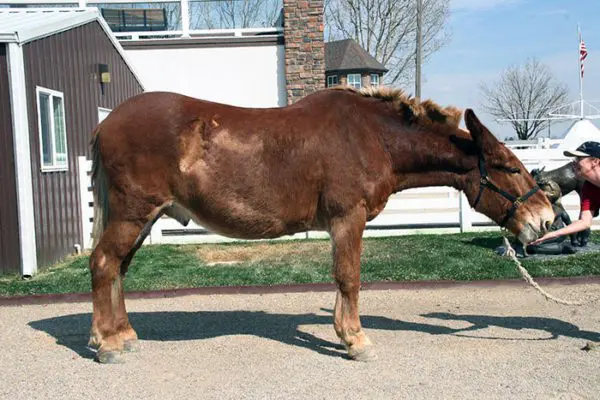 Everything we do, every behavior we choose, is based on an instinctual desire to experience pleasure and avoid pain. Our choices reflect our experience. They are “reinforced” by the pain or pleasure they have given us in the past. Behavior Modification uses the same principles of positive and negative reinforcement with an emphasis on positive reinforcement.
Everything we do, every behavior we choose, is based on an instinctual desire to experience pleasure and avoid pain. Our choices reflect our experience. They are “reinforced” by the pain or pleasure they have given us in the past. Behavior Modification uses the same principles of positive and negative reinforcement with an emphasis on positive reinforcement. Positive reinforcement also takes the form of verbal cues. When your animal performs the desired behavior, you should, simultaneously and with appropriate enthusiasm, say the word, “Good!” This works well when it isn’t possible to give a food reward right away. Clicker training, which has become a popular and effective means of audible reinforcement, is similar and applies the same concept. It’s immediate, it’s consistent, and it can be used with all mules, donkeys and horses to reinforce behavior. However, I feel that it is better to use your voice than a clicker, as the sound of your voice promotes engagement with your equine on a more intimate level, so your voice will yield better results than clicker training.
Positive reinforcement also takes the form of verbal cues. When your animal performs the desired behavior, you should, simultaneously and with appropriate enthusiasm, say the word, “Good!” This works well when it isn’t possible to give a food reward right away. Clicker training, which has become a popular and effective means of audible reinforcement, is similar and applies the same concept. It’s immediate, it’s consistent, and it can be used with all mules, donkeys and horses to reinforce behavior. However, I feel that it is better to use your voice than a clicker, as the sound of your voice promotes engagement with your equine on a more intimate level, so your voice will yield better results than clicker training.
 As your equine learns certain behaviors, you can reinforce the learned behaviors less frequently and focus on frequently rewarding new achievements. Gradually, your animal will become satisfied with a verbal reinforcement for established behaviors, and he will comply for longer periods between food rewards. This shift from a predictable, or fixed, schedule of reinforcement to a variableschedule helps with skill progression. For example, in the transition from lunging when your animal was initially given a reward after each set of rotations in the round pen, to riding, he can eventually be ridden through his entire 30 to 40 minute session before receiving a reward.
As your equine learns certain behaviors, you can reinforce the learned behaviors less frequently and focus on frequently rewarding new achievements. Gradually, your animal will become satisfied with a verbal reinforcement for established behaviors, and he will comply for longer periods between food rewards. This shift from a predictable, or fixed, schedule of reinforcement to a variableschedule helps with skill progression. For example, in the transition from lunging when your animal was initially given a reward after each set of rotations in the round pen, to riding, he can eventually be ridden through his entire 30 to 40 minute session before receiving a reward.







 Mules played an important role in our country during the Reconstruction Period: they patiently worked the fields, packed necessary artillery for the army, and served as a durable riding and driving animal in the westward movement. With the coming of the industrial age, their uses were minimized and they were faced with the possibility of extinction in the march of progress. Today, through the persistent determination of mule enthusiasts, mules are once again emerging as a conceivable asset to our economy and a unique form of athletic achievement and entertainment.
Mules played an important role in our country during the Reconstruction Period: they patiently worked the fields, packed necessary artillery for the army, and served as a durable riding and driving animal in the westward movement. With the coming of the industrial age, their uses were minimized and they were faced with the possibility of extinction in the march of progress. Today, through the persistent determination of mule enthusiasts, mules are once again emerging as a conceivable asset to our economy and a unique form of athletic achievement and entertainment. They will generally follow you around until you leave the field, begging for attention or simply observing you closely from a safe distance. Mules have a genuine desire to make friends with those other than their own species. Also, they are a very sensitive animal and can read your intentions through the tone of your voice and your body language.
They will generally follow you around until you leave the field, begging for attention or simply observing you closely from a safe distance. Mules have a genuine desire to make friends with those other than their own species. Also, they are a very sensitive animal and can read your intentions through the tone of your voice and your body language. Still, the most important thing to remember is to praise the mule with caressing and scratching when he does what you desire and back it up with the food reward. Mules love this kind of attention and will do their best to get it. If they are rewarded immediately when they are behaving as desired, the desired behavior will eventually become the norm. If bad behavior is ignored or gently reprimanded, it will fade to a minimum. The result is a pleasant, affectionate, and dependable animal.
Still, the most important thing to remember is to praise the mule with caressing and scratching when he does what you desire and back it up with the food reward. Mules love this kind of attention and will do their best to get it. If they are rewarded immediately when they are behaving as desired, the desired behavior will eventually become the norm. If bad behavior is ignored or gently reprimanded, it will fade to a minimum. The result is a pleasant, affectionate, and dependable animal.
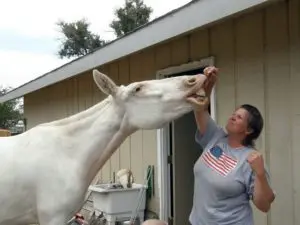
 published on this subject and what was published was extremely limited and devoid of detail. Those of us who were training needed to rely on educational resources that were designed for horse training and modify those techniques to better suit our Longears. This still left a lot of room for trial and error…and a lot of frustration for both the trainer and the Longears.
published on this subject and what was published was extremely limited and devoid of detail. Those of us who were training needed to rely on educational resources that were designed for horse training and modify those techniques to better suit our Longears. This still left a lot of room for trial and error…and a lot of frustration for both the trainer and the Longears. Seminars and clinics can be helpful, but they can never replace the day to day routine helps the Longears learn to trust his owner and his situation with minimal anxiety. This limits his ability to become a safe, obedient and dependable companion. Mules and donkeys bond deeply to those who manage and train them. They develop warmth and affection for them, and a strong desire to please and serve. Without this kind of bond, mules and donkeys will often comply, but without true commitment to their work. Subsequently, when the pressure is on, their response may be to simply “quit.”
Seminars and clinics can be helpful, but they can never replace the day to day routine helps the Longears learn to trust his owner and his situation with minimal anxiety. This limits his ability to become a safe, obedient and dependable companion. Mules and donkeys bond deeply to those who manage and train them. They develop warmth and affection for them, and a strong desire to please and serve. Without this kind of bond, mules and donkeys will often comply, but without true commitment to their work. Subsequently, when the pressure is on, their response may be to simply “quit.” active part in the management and training of their Longears. Boarding stables are not a good option. Even if your mule or donkey is with a competent trainer, you need to plan on spending at least two days a week with him and the trainer, so your Longears can learn to trust you, too! Being present and interactive with your equine at feeding time, morning and evening, is only a beginning of building the trust between you.
active part in the management and training of their Longears. Boarding stables are not a good option. Even if your mule or donkey is with a competent trainer, you need to plan on spending at least two days a week with him and the trainer, so your Longears can learn to trust you, too! Being present and interactive with your equine at feeding time, morning and evening, is only a beginning of building the trust between you. Time and time again, my training series has proven that this really was a great approach. It enabled me to reach people and help them to attain new levels of communication with their equines. People who never before had the courage, nor the confidence to even try, are discovering the self satisfaction and elation that follows when you attempt to train your own Longears! Most people tell me it is the best part of their day when they can work with their equines, no matter what they are doing together. They are quite surprised to find out how easy it is to establish a routine that fits with their other weekly activities…thanks to the intelligence and forgiveness of these wonderful Longears!
Time and time again, my training series has proven that this really was a great approach. It enabled me to reach people and help them to attain new levels of communication with their equines. People who never before had the courage, nor the confidence to even try, are discovering the self satisfaction and elation that follows when you attempt to train your own Longears! Most people tell me it is the best part of their day when they can work with their equines, no matter what they are doing together. They are quite surprised to find out how easy it is to establish a routine that fits with their other weekly activities…thanks to the intelligence and forgiveness of these wonderful Longears! the forgiveness of these wonderful animals in the face of my own impatience and ignorance. They were the ones that let me know when my approach to training was unrealistic and punitive, and did so in an all-knowing and careful way. My lessons with them were proportionate to my mistakes, so I was lucky enough not to experience any severe head injuries, or broken bones. When these kinds of injuries occur, there is something grossly wrong between the animal and the person that has been injured. It could be a lot of reasons, but the one thing of which I can be sure is that the Longears always acted honestly and appropriately. They cannot be any other way. The problems occurred because of my own lack of communication…I wasn’t listening to what they were trying to convey to me!
the forgiveness of these wonderful animals in the face of my own impatience and ignorance. They were the ones that let me know when my approach to training was unrealistic and punitive, and did so in an all-knowing and careful way. My lessons with them were proportionate to my mistakes, so I was lucky enough not to experience any severe head injuries, or broken bones. When these kinds of injuries occur, there is something grossly wrong between the animal and the person that has been injured. It could be a lot of reasons, but the one thing of which I can be sure is that the Longears always acted honestly and appropriately. They cannot be any other way. The problems occurred because of my own lack of communication…I wasn’t listening to what they were trying to convey to me!
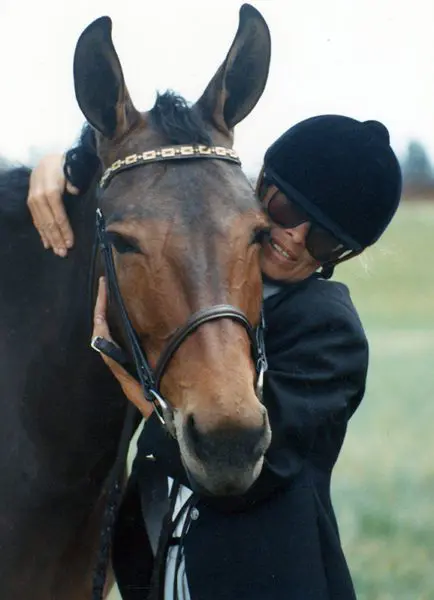 No training series would be complete without examination of the principles and philosophy behind the training techniques. The philosophy of my training techniques is based on the principle that we are not, in fact, training our equines. In fact, we are cultivating relationships with them by assigning meaning to our own body language that they can understand.
No training series would be complete without examination of the principles and philosophy behind the training techniques. The philosophy of my training techniques is based on the principle that we are not, in fact, training our equines. In fact, we are cultivating relationships with them by assigning meaning to our own body language that they can understand.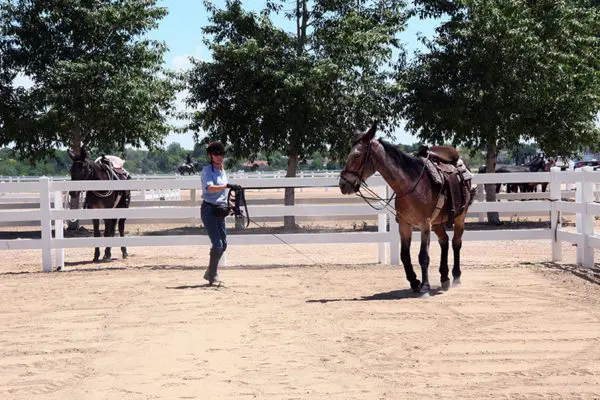 For instance, we had a 3-year-old mule learning to lunge without the benefit of the round pen. The problem was that she refused to go around you more than a couple of times without running off. Assess the situation first by brainstorming all the probable reasons she might keep doing such an annoying thing. Is she frightened? Is she bored? Is she mischievous? Has she been calm and accepting of most things until now? And most important, is my own body language causing this to occur?
For instance, we had a 3-year-old mule learning to lunge without the benefit of the round pen. The problem was that she refused to go around you more than a couple of times without running off. Assess the situation first by brainstorming all the probable reasons she might keep doing such an annoying thing. Is she frightened? Is she bored? Is she mischievous? Has she been calm and accepting of most things until now? And most important, is my own body language causing this to occur?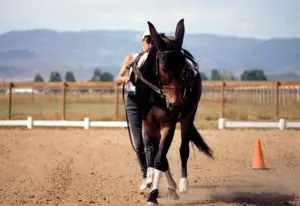 As mental changes occur, so do physical changes. As muscles develop and coordination gets better, the animal will gain confidence. As a trainer, you will need to do less and less to cause certain movements. For example, in the case of the leg yield, you may have to turn your mule’s head a little in the opposite direction to get him to step sideways and forward. As he becomes stronger, more coordinated, and understands your request, you can then begin to straighten his body more with less effort. Granted, we have begun by doing this the wrong way, yet we have put our mule “on the road” to the right way. We have assimilated an action in response to our leg that can now be perfected over time. In essence, you have simply said, “First you learn to move away from my leg, then you can learn to do it gracefully!”
As mental changes occur, so do physical changes. As muscles develop and coordination gets better, the animal will gain confidence. As a trainer, you will need to do less and less to cause certain movements. For example, in the case of the leg yield, you may have to turn your mule’s head a little in the opposite direction to get him to step sideways and forward. As he becomes stronger, more coordinated, and understands your request, you can then begin to straighten his body more with less effort. Granted, we have begun by doing this the wrong way, yet we have put our mule “on the road” to the right way. We have assimilated an action in response to our leg that can now be perfected over time. In essence, you have simply said, “First you learn to move away from my leg, then you can learn to do it gracefully!”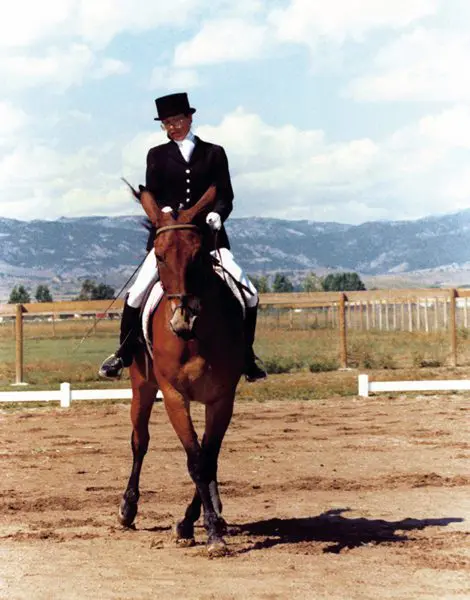 In training horses and mules, there is really little difference in one’s techniques or approach, provided we maintain patience and understanding and a good rewards system. The major difference between these two equines is their ability to tolerate negative reinforcement, or punishment. The mule, being part donkey, does not tolerate punitive action very well unless he is fully aware that the fault was his own and the punishment is fair. For instance, you ask for a canter lead and your mule keeps trotting, one good smack with the whip, or one good gig with the spurs, is negative reinforcement that will bring about the desired response, but be careful of an over-reaction from an overdone cue. More than one good smack or gig could cause either a runaway or an extremely balky animal. This kind of resistance comes from the donkey and requires a much different approach when training donkeys. The horse part of the mule allows us an easier time of overcoming this type of resistance in mules, making them different and easier to train than donkeys.
In training horses and mules, there is really little difference in one’s techniques or approach, provided we maintain patience and understanding and a good rewards system. The major difference between these two equines is their ability to tolerate negative reinforcement, or punishment. The mule, being part donkey, does not tolerate punitive action very well unless he is fully aware that the fault was his own and the punishment is fair. For instance, you ask for a canter lead and your mule keeps trotting, one good smack with the whip, or one good gig with the spurs, is negative reinforcement that will bring about the desired response, but be careful of an over-reaction from an overdone cue. More than one good smack or gig could cause either a runaway or an extremely balky animal. This kind of resistance comes from the donkey and requires a much different approach when training donkeys. The horse part of the mule allows us an easier time of overcoming this type of resistance in mules, making them different and easier to train than donkeys.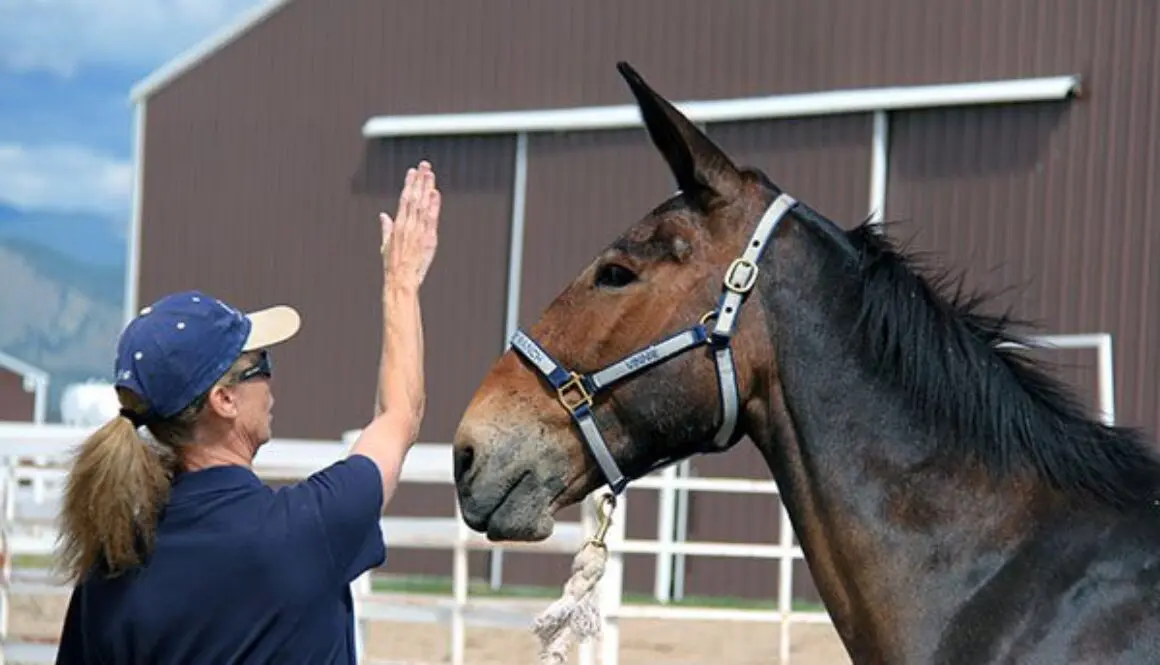
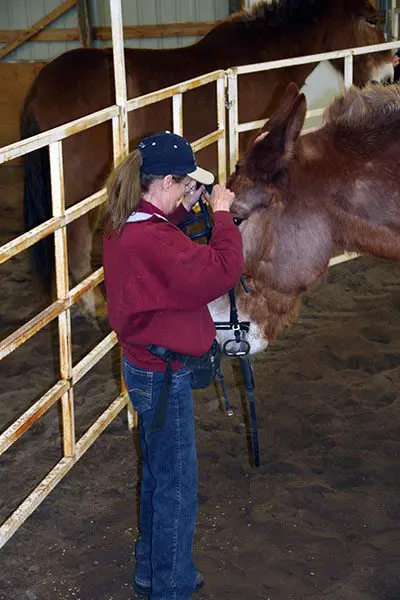 When people think of Behavior Modification, most people think of the basest idea of rewarding good behaviors with treats which is commonly called positive reinforcement. A common misconception is that if positive behaviors are rewarded, then negative behaviors should not occur, but in reality, they do. Negative behaviors need to be negatively reinforced, or discouraged, but the negative reinforcement should be punitive, but not abusive. Learning how to employ Behavior Modification can be easy and fun.
When people think of Behavior Modification, most people think of the basest idea of rewarding good behaviors with treats which is commonly called positive reinforcement. A common misconception is that if positive behaviors are rewarded, then negative behaviors should not occur, but in reality, they do. Negative behaviors need to be negatively reinforced, or discouraged, but the negative reinforcement should be punitive, but not abusive. Learning how to employ Behavior Modification can be easy and fun.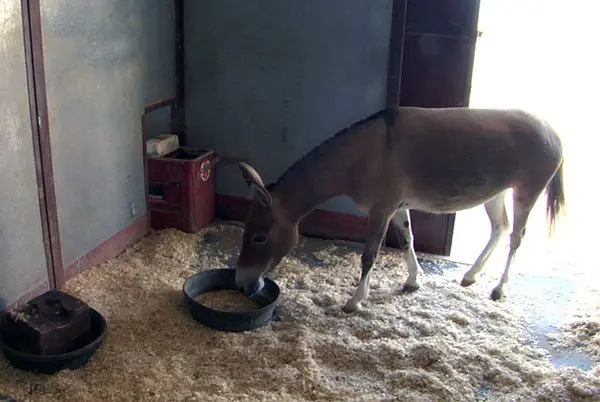 When using Behavior Modification, one needs to take into account all the things that can make that individual comfortable and happy. In the case of equines, we need to take into account the feeding and nutritional programs we use. Certain feeds can actually cause problems like nervousness, anxiety and hypertension that can result in an inability to be calm and receptive to incoming information. From this evolves negative behaviors that block the learning process.
When using Behavior Modification, one needs to take into account all the things that can make that individual comfortable and happy. In the case of equines, we need to take into account the feeding and nutritional programs we use. Certain feeds can actually cause problems like nervousness, anxiety and hypertension that can result in an inability to be calm and receptive to incoming information. From this evolves negative behaviors that block the learning process.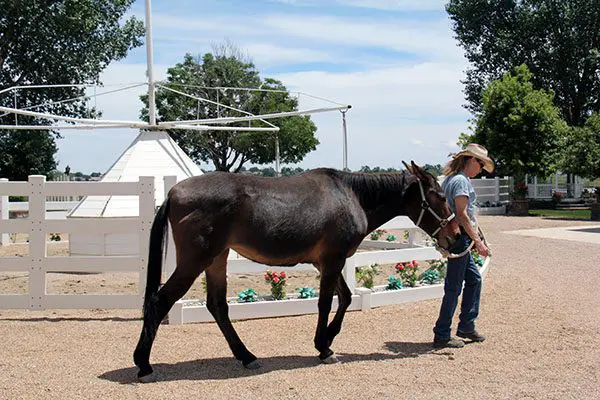 It is easy for natural athletes, but as I said before, we are dealing with individuals and each one is unique. Not all individuals are physically able to carry their bodies in good equine posture, and perform athletic movements correctly without some guidance. When they do not carry their bodies in good equine posture, certain muscle groups are not conditioned symmetrically throughout the body. This will cause compensation from other muscle groups that will eventually become over-used, stressed and they will give way to soreness, lameness, or worse. The uncomfortable individual will begin to exhibit negative behaviors as a result.
It is easy for natural athletes, but as I said before, we are dealing with individuals and each one is unique. Not all individuals are physically able to carry their bodies in good equine posture, and perform athletic movements correctly without some guidance. When they do not carry their bodies in good equine posture, certain muscle groups are not conditioned symmetrically throughout the body. This will cause compensation from other muscle groups that will eventually become over-used, stressed and they will give way to soreness, lameness, or worse. The uncomfortable individual will begin to exhibit negative behaviors as a result.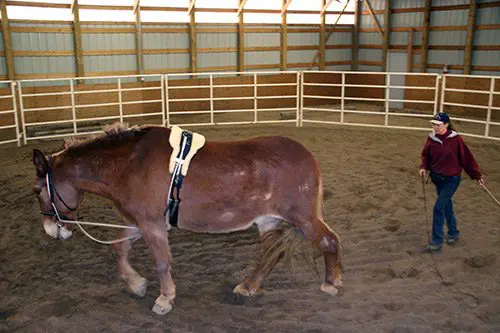 is something that must be taught, it prevents this bad posture, but allows the equine completely free movement in every other direction. Good posture is difficult to hold when you are not used to it and this aid gives him support at the poll to encourage him to round his back and neck, and relax the poll. He can lean on the “Elbow Pull” at the poll when he has difficulty holding his own good posture and the device will be snug at the poll, the bit rings, behind the forearms and over the back. When he holds his own good posture, it is completely loose. The equine is the one who controls his own good posture. An equine that does not have natural acceptable posture will soon give to the aid because he will feel more comfortable than he has ever been in his incorrect posture. Those who have naturally acceptable posture will succumb to the device faster. No equine is really in their ideal posture to start. Restraints play an important role in the hands of competent trainers, but they should only be used to suggest certain behaviors, and then they should be phased out over time. They should not be used to force the equine to do anything.
is something that must be taught, it prevents this bad posture, but allows the equine completely free movement in every other direction. Good posture is difficult to hold when you are not used to it and this aid gives him support at the poll to encourage him to round his back and neck, and relax the poll. He can lean on the “Elbow Pull” at the poll when he has difficulty holding his own good posture and the device will be snug at the poll, the bit rings, behind the forearms and over the back. When he holds his own good posture, it is completely loose. The equine is the one who controls his own good posture. An equine that does not have natural acceptable posture will soon give to the aid because he will feel more comfortable than he has ever been in his incorrect posture. Those who have naturally acceptable posture will succumb to the device faster. No equine is really in their ideal posture to start. Restraints play an important role in the hands of competent trainers, but they should only be used to suggest certain behaviors, and then they should be phased out over time. They should not be used to force the equine to do anything.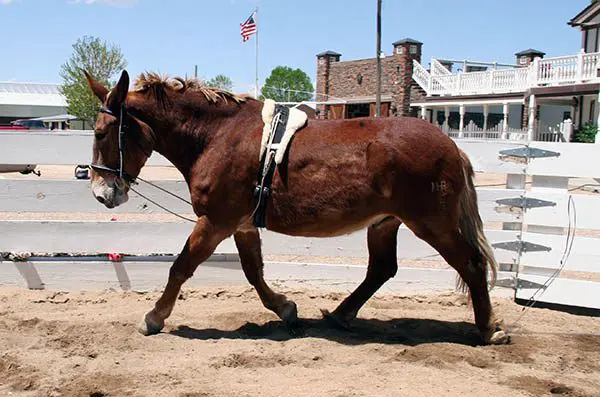 synchronize his own body language with what he is asking from the equine so his signals are clear. This is especially important for novice animals and trainers.
synchronize his own body language with what he is asking from the equine so his signals are clear. This is especially important for novice animals and trainers.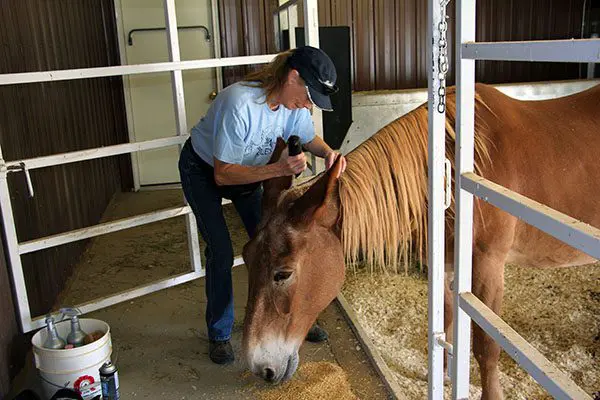 During this time, your equine’s ground manners will begin to develop. If you are consistent with what and how you ask, when the rewards are prompt and appropriately given, you should experience minimal adverse behaviors.
During this time, your equine’s ground manners will begin to develop. If you are consistent with what and how you ask, when the rewards are prompt and appropriately given, you should experience minimal adverse behaviors.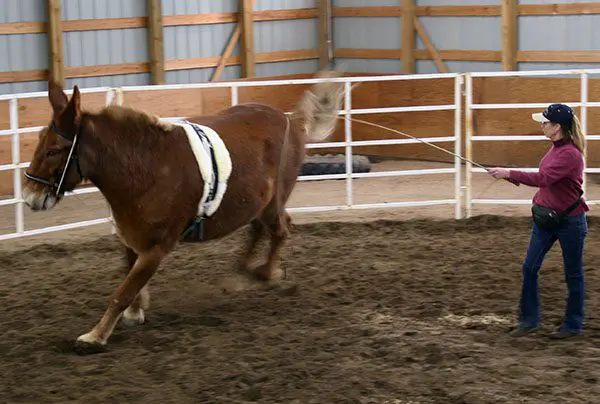 The strike on the fetlocks will not hurt him. It will only startle him and get his attention. Your voice will also startle him when you say, “NO!” and will cause him to turn his head to you and THAT can be rewarded. Biting is handled the same way with a firm slap of your palm on the side of his mouth, a loud “NO!” and then put up your hand like a stop sign in front of his face. He will raise and turn his head to flee at which time you simply step forward and offer the oats reward with an open hand for giving you your space. The next time he becomes aggressive (and he will!), you will only need to raise your hand like a stop sign and he should step back to receive his reward. The first-time slap applied smartly was simply to clarify the boundary to his behavior. So, if you do not want to slap him again, you have to make a firm impression on him the first time! It is well worth the few minutes of training that it takes in the beginning to ensure that your animal does not become dangerous later. This may literally make the difference between life and death.
The strike on the fetlocks will not hurt him. It will only startle him and get his attention. Your voice will also startle him when you say, “NO!” and will cause him to turn his head to you and THAT can be rewarded. Biting is handled the same way with a firm slap of your palm on the side of his mouth, a loud “NO!” and then put up your hand like a stop sign in front of his face. He will raise and turn his head to flee at which time you simply step forward and offer the oats reward with an open hand for giving you your space. The next time he becomes aggressive (and he will!), you will only need to raise your hand like a stop sign and he should step back to receive his reward. The first-time slap applied smartly was simply to clarify the boundary to his behavior. So, if you do not want to slap him again, you have to make a firm impression on him the first time! It is well worth the few minutes of training that it takes in the beginning to ensure that your animal does not become dangerous later. This may literally make the difference between life and death.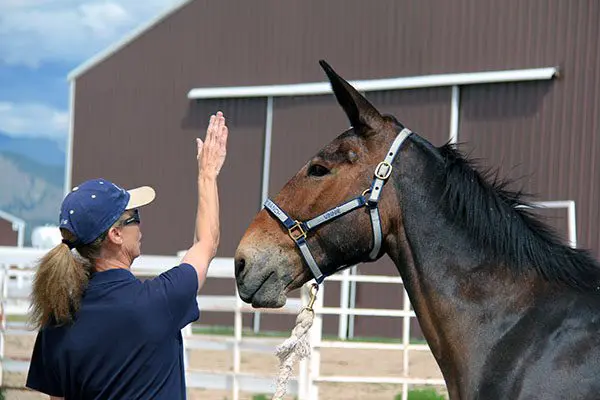 The result of this early limiting of the negative behaviors (of biting and kicking), will pave the way for you to set boundaries to any other questionable behaviors that might arise in the future. All it should take is the raising of your hand and a firm “NO!” It teaches the equine to think before he acts. It might mean the difference between a real bite, or nip, and a soft nudge, or a kick, and a soft shove with a hind foot when he experiences discomfort. Early negotiation of obstacles on the lead rope will also help to engage his curiosity, help to solidify his responses for rewards, passively build and condition the muscles closet to the bone, and will encourage trust in his trainer. Now we can safely proceed to a more open area to play and learn with our equine.
The result of this early limiting of the negative behaviors (of biting and kicking), will pave the way for you to set boundaries to any other questionable behaviors that might arise in the future. All it should take is the raising of your hand and a firm “NO!” It teaches the equine to think before he acts. It might mean the difference between a real bite, or nip, and a soft nudge, or a kick, and a soft shove with a hind foot when he experiences discomfort. Early negotiation of obstacles on the lead rope will also help to engage his curiosity, help to solidify his responses for rewards, passively build and condition the muscles closet to the bone, and will encourage trust in his trainer. Now we can safely proceed to a more open area to play and learn with our equine.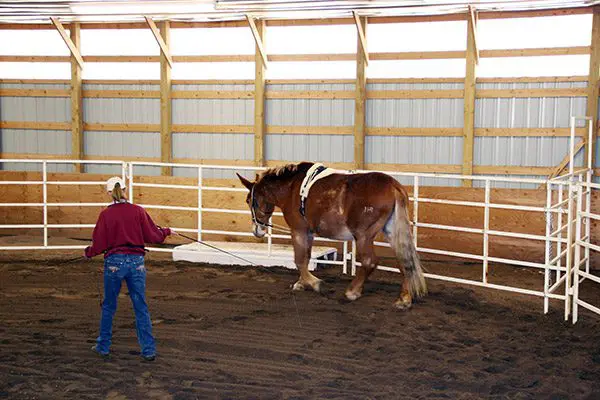 The same goes for the equine that had problems getting started. Send him back to the rail again and build the number of expected rotations slowly and over time. Be consistent with your rewards for the “Whoa.” Learning the consistent, “Whoa” will give you a safe zone from which to work and play. This will translate to trust and confidence, and will temper the flight reflex to a controllable level. It can make the difference between the freeze and flight reflex if the equine is spooked under saddle.
The same goes for the equine that had problems getting started. Send him back to the rail again and build the number of expected rotations slowly and over time. Be consistent with your rewards for the “Whoa.” Learning the consistent, “Whoa” will give you a safe zone from which to work and play. This will translate to trust and confidence, and will temper the flight reflex to a controllable level. It can make the difference between the freeze and flight reflex if the equine is spooked under saddle.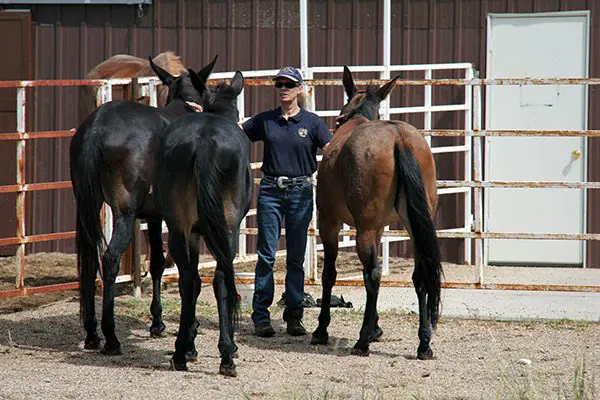 into your program. As they say, “You can always learn something from everyone!” It is our job to sort through what only works for the short term, and what really works for long term success. Don’t be afraid to make mistakes. It’s just one more way to learn. The more we think we know, the more we learn that there is so much more to learn!
into your program. As they say, “You can always learn something from everyone!” It is our job to sort through what only works for the short term, and what really works for long term success. Don’t be afraid to make mistakes. It’s just one more way to learn. The more we think we know, the more we learn that there is so much more to learn!